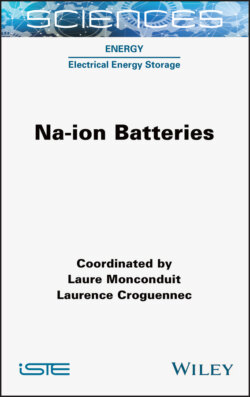Читать книгу Na-ion Batteries - Laure Monconduit - Страница 25
1.3.1.2. O3-NaCrO2
ОглавлениеIn contrast to O3-NaScO2, O3-NaTiO2 and O3-NaVO2, O3-NaMO2 (M = Cr, Mn, Fe, Co, Ni) exhibits relatively high working voltages suitable for the positive electrodes of Na-ion batteries. O3-NaCrO2 delivers a reversible capacity of 110 mAh g−1 with an average working voltage of 3.02 V in a voltage range of 2.5–3.6 V (Figure 1.8) (Komaba et al. 2009, 2010).
Figure 1.8. Comparison of galvanostatic charge/discharge curves of layered O3 and O’3 type single 3d transition metal oxides (left). Morphology of particles for each sample is also compared (right)
It should be noted that O3-LiCrO2 is electrochemically inactive in a Li cell (Komaba et al. 2010) and electrochemical behaviors of layered CrO2 are quite different in between Li and Na cells. O3-NaCrO2 exhibits reversible structural changes in the O3 → O’3 → P’3 sequence by Na extraction to x = 0.5 in NaxCrO2 upon charging to 3.6 V versus Na (Komaba et al. 2009; Chen et al. 2013; Zhou et al. 2013; Kubota et al. 2015a). Further, Na extraction to x < 0.5 in NaxCrO2 causes an irreversible structural change, resulting in almost no reversible capacity (Figure 1.9(a)) (Kubota et al. 2015a; Bo et al. 2016).
Figure 1.9. (a) Initial charge and discharge curves of Na//NaCrO2 cells at a rate of 12.5 mA g−1 in the ranges of 0.0 ≤ x ≤ 0.5 and 0.0 ≤ x ≤ 0.7 in Na1−xCrO2 and in a voltage range of 2.5−4.5 V. Reprinted with permission from Kubota et al. (2015a). Copyright 2015, American Chemical Society. (b) Rietveld refinements for the sample that was charged to the end of the 3.8 V plateau. Reprinted with permission from Bo et al. (2016). Copyright 2016, American Chemical Society. (c) Mechanism of transition metal migration on the sodium extraction process. Reprinted with permission from Kubota et al. (2015a). Copyright 2015, American Chemical Society. For a color version of this figure, see www.iste.co.uk/monconduit/batteries.zip
The migrated chromium ions into the interslab space were detected with XRD (Figure 1.9(b)), electron diffraction (ED), and X-ray absorption spectroscopy (XAS) (Kubota et al. 2015a; Bo et al. 2016). The presumed migration mechanism is shown as schematic illustrations in Figure 1.9(c). Transition metal ions irreversibly migrate from the slab into interslab, resulting in disturbing Na insertion on discharge (Kubota et al. 2015a; Bo et al. 2016). Even in 2.5–3.6 V, capacity decay is observed in Na cells filled with carbonate ester-based electrolyte, which is probably due to electrolyte decomposition on the surface of O3-NaCrO2. To suppress the side reaction on the surface, Du et al. synthesized large-grained O3-NaCrO2 from Na2Cr2O7·2H2O and demonstrated a large reversible capacity of 123 mAh g−1 and a high tap density of 2.55 g cm−3 (Wang et al. 2019c). Yu et al. carried out surface coating on the O3-NaCrO2 particles with carbon. Carbon-coated O3-NaCrO2 delivers a larger reversible capacity of 120 mAh g−1 and exhibits superior capacity retention and rate performance in the Na cells and a hard carbon//O3-NaCrO2 full cell (Yu et al. 2015). Among the single 3d transition metal O3 type systems, charge/discharge behaviors of O3-NaCrO2 such as large reversible capacity, excellent capacity retention and rate performance, non-stepwise and slightly inclined voltage curves are suitable as a positive electrode material for practical use in Na-ion batteries. Actually, Sumitomo Electric Industries, Ltd. made prototype Zn-Na alloy//O3-NaCrO2 cells with the molten salt of sodium bis(fluorosulfonyl)amide (NaFSA) and potassium bis(fluorosulfonyl)amide (KFSA) as electrolyte, and battery and safety performances were reported (Nitta et al. 2013). Despite the toxicity issue of chromium, O3-NaCrO2 has been used as a standard positive electrode material to evaluate performance of Na-ion batteries. Furthermore, Na0.5CrO2 shows high thermal stability in NaPF6-based electrolyte, higher than those of Li0.5CoO2 and LixNi1/3Mn1/3Co1/3O2 in a LiPF6-based electrolyte, which is evidenced by accelerating rate calorimetry (Xia and Dahn 2012) and explained with phase transitions without oxygen generation below 477°C (Yabuuchi et al. 2016).
